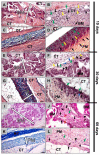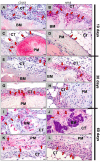The Early Fragmentation of a Bovine Dermis-Derived Collagen Barrier Membrane Contributes to Transmembraneous Vascularization-A Possible Paradigm Shift for Guided Bone Regeneration
- PMID: 33803205
- PMCID: PMC7999168
- DOI: 10.3390/membranes11030185
The Early Fragmentation of a Bovine Dermis-Derived Collagen Barrier Membrane Contributes to Transmembraneous Vascularization-A Possible Paradigm Shift for Guided Bone Regeneration
Abstract
Collagen-based barrier membranes are an essential component in Guided Bone Regeneration (GBR) procedures. They act as cell-occlusive devices that should maintain a micromilieu where bone tissue can grow, which in turn provides a stable bed for prosthetic implantation. However, the standing time of collagen membranes has been a challenging area, as native membranes are often prematurely resorbed. Therefore, consolidation techniques, such as chemical cross-linking, have been used to enhance the structural integrity of the membranes, and by consequence, their standing time. However, these techniques have cytotoxic tendencies and can cause exaggerated inflammation and in turn, premature resorption, and material failures. However, tissues from different extraction sites and animals are variably cross-linked. For the present in vivo study, a new collagen membrane based on bovine dermis was extracted and compared to a commercially available porcine-sourced collagen membrane extracted from the pericardium. The membranes were implanted in Wistar rats for up to 60 days. The analyses included well-established histopathological and histomorphometrical methods, including histochemical and immunohistochemical staining procedures, to detect M1- and M2-macrophages as well as blood vessels. Initially, the results showed that both membranes remained intact up to day 30, while the bovine membrane was fragmented at day 60 with granulation tissue infiltrating the implantation beds. In contrast, the porcine membrane remained stable without signs of material-dependent inflammatory processes. Therefore, the bovine membrane showed a special integration pattern as the fragments were found to be overlapping, providing secondary porosity in combination with a transmembraneous vascularization. Altogether, the bovine membrane showed comparable results to the porcine control group in terms of biocompatibility and standing time. Moreover, blood vessels were found within the bovine membranes, which can potentially serve as an additional functionality of barrier membranes that conventional barrier membranes do not provide.
Keywords: Guided Bone Regeneration (GBR); barrier membrane; bovine collagen; bovine dermis; porcine collagen; porcine pericardium; tissue regeneration; tissue source; transmembraneous vascularization.
Conflict of interest statement
The authors declare no conflict of interest.
Figures





Similar articles
-
In Vivo Biocompatibility Analysis of a Novel Barrier Membrane Based on Bovine Dermis-Derived Collagen for Guided Bone Regeneration (GBR).Membranes (Basel). 2022 Mar 30;12(4):378. doi: 10.3390/membranes12040378. Membranes (Basel). 2022. PMID: 35448348 Free PMC article.
-
Novel Histomorphometrical Approach to Evaluate the Integration Pattern and Functionality of Barrier Membranes.Dent J (Basel). 2021 Oct 25;9(11):127. doi: 10.3390/dj9110127. Dent J (Basel). 2021. PMID: 34821591 Free PMC article.
-
Comparative In Vivo Analysis of the Integration Behavior and Immune Response of Collagen-Based Dental Barrier Membranes for Guided Bone Regeneration (GBR).Membranes (Basel). 2021 Sep 15;11(9):712. doi: 10.3390/membranes11090712. Membranes (Basel). 2021. PMID: 34564529 Free PMC article.
-
[Use of native and cross-linked collagen membranes for guided tissue and bone regeneration].Schweiz Monatsschr Zahnmed. 2006;116(11):1112-23. Schweiz Monatsschr Zahnmed. 2006. PMID: 17144624 Review. German.
-
[Research progress on the modification of guided bone regeneration membranes].Hua Xi Kou Qiang Yi Xue Za Zhi. 2019 Jun 1;37(3):325-329. doi: 10.7518/hxkq.2019.03.019. Hua Xi Kou Qiang Yi Xue Za Zhi. 2019. PMID: 31218871 Free PMC article. Review. Chinese.
Cited by
-
Comparison of the Validity of Enzymatic and Immunohistochemical Detection of Tartrate-resistant Acid Phosphatase (TRAP) in the Context of Biocompatibility Analyses of Bone Substitutes.In Vivo. 2022 Sep-Oct;36(5):2042-2051. doi: 10.21873/invivo.12930. In Vivo. 2022. PMID: 36099106 Free PMC article.
-
In Vivo Biocompatibility Analysis of a Novel Barrier Membrane Based on Bovine Dermis-Derived Collagen for Guided Bone Regeneration (GBR).Membranes (Basel). 2022 Mar 30;12(4):378. doi: 10.3390/membranes12040378. Membranes (Basel). 2022. PMID: 35448348 Free PMC article.
-
Novel Histomorphometrical Approach to Evaluate the Integration Pattern and Functionality of Barrier Membranes.Dent J (Basel). 2021 Oct 25;9(11):127. doi: 10.3390/dj9110127. Dent J (Basel). 2021. PMID: 34821591 Free PMC article.
-
In Vivo Analysis of the Immune Response to Strontium- and Copper-doped Bioglass.In Vivo. 2022 Sep-Oct;36(5):2149-2165. doi: 10.21873/invivo.12941. In Vivo. 2022. PMID: 36099113 Free PMC article.
-
The influence of different crosslinking agents onto the physical properties, integration behavior and immune response of collagen-based barrier membranes.Front Bioeng Biotechnol. 2025 Jan 6;12:1506433. doi: 10.3389/fbioe.2024.1506433. eCollection 2024. Front Bioeng Biotechnol. 2025. PMID: 39834629 Free PMC article.
References
-
- Ghanaati S. In vivo Implantation of a Bovine-Derived Collagen Membrane Leads to Changes in the Physiological Cellular Pattern of Wound Healing by the Induction of Multinucleated Giant Cells: An Adverse Reaction? Front. Bioeng. Biotechnol. 2018;6:1–13. doi: 10.3389/fbioe.2018.00104. - DOI - PMC - PubMed
LinkOut - more resources
Full Text Sources
Other Literature Sources

